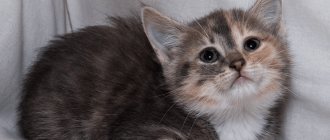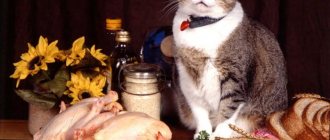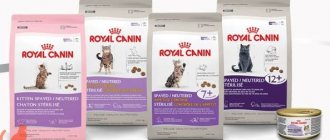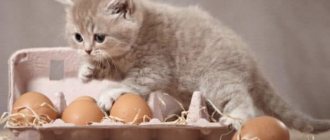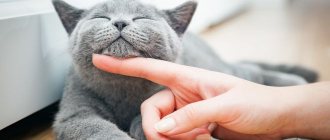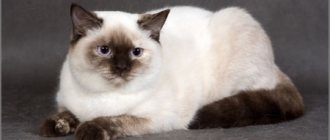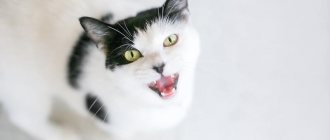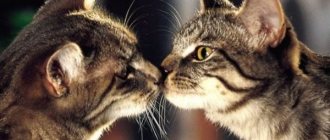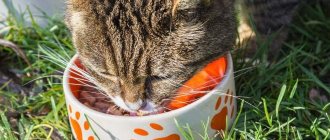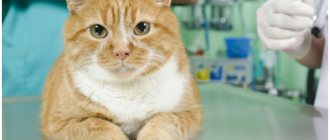Many people make a lot of efforts to get rid of extra pounds, but for some reason they are touched by the sight of a fat, imposing cat. But the problem of excess weight for cats is as acute as for their owners. Excessive fat deposits in the subcutaneous tissue, various organs and tissues are the result of overfeeding, low physical activity and threaten the development of many dangerous diseases, disability and even death of the animal. We must understand that obesity in cats is not a reason for delight and tenderness, it is a serious pathology. A sick animal needs proper treatment. From this article you will learn how to determine if a pet is obese, what to do to get rid of excess weight, and how to deal with the complications that this disease entails.
Types of obesity
In cats (as in people), depending on the causes, there are two types of obesity - primary and secondary.
- Primary obesity is also called nutritional obesity. It is based on incorrectly formed dietary preferences, leading to an energy imbalance in the body, as well as hereditary-constitutional factors (inheritance of a tendency to be overweight from ancestors). This type of obesity in cats is an independent disease that can be treated.
- Secondary obesity is called symptomatic. It is only a symptom of a malfunction of other organs (most often the brain or endocrine glands), as a result of which the metabolic rate changes and a pathological appetite appears. In this case, it is not obesity itself that needs to be treated, but its root cause.
Symptoms
It is not always possible to determine whether a cat is obese simply by weighing it. Different cat breeds have certain sizes and weight standards. You can compare the average parameters for a particular species, but these figures are quite approximate. The animal may simply be large enough for its breed or may be outbred.
To get the most accurate result when weighing your pet, you just need to take it into your arms and weigh it together on a floor scale, then weigh yourself. After subtracting the results, you will get your pet's true weight.
A more reliable indicator of obesity and suitable for any type of cat is a routine examination.
Your pet is in good shape - you can easily feel the ribs and shoulder blades, the belly is tucked in and has a thin layer of fat. Movements are light and graceful.
Your pet is obese - you cannot feel the spine and pelvic bones, his life is saggy and has a thick layer of fat. The movements are slow, “waddling”.
Causes
There are several main reasons why cats develop obesity:
- energy imbalance (predominance of the amount of incoming energy over the energy expenditure of the body);
- lipid imbalance (the predominance of the amount of fat consumed over the body’s ability to burn it);
- metabolic disorders and hormonal imbalances in the body;
- burdened heredity.
What do you need to optimize your weight?
First of all, you need to understand that cats lose body weight poorly and slowly. All family members should be interested in normalizing the pet's weight and adhere to the recommended norms. The animal's lifestyle is completely changed - from the nature of its diet to the feeding process itself.
The energy requirement is calculated by the veterinarian based on the cat's body weight, activity and age. The doctor takes into account all the nuances to ensure that the pet receives the necessary vitamins and minerals. A feeding plan is drawn up, which includes the following items:
- target weight is outlined (step by step);
- a period of weight loss is planned (the actual time frame for a cat is 6–8 months. If there is a high degree of obesity – up to 9–12 months);
- safe weight loss regimen (1–2% per month).
Provoking factors
There are also certain factors, the presence of which provokes obesity in cats:
- overfeeding the animal;
- low physical activity;
- unbalanced diet;
- sterilization or castration of animals;
- endocrinological diseases;
- hormonal therapy and the use of oral contraceptives;
- breed and genetic predisposition;
- senior and old age.
Overfeeding an animal
The most common risk factor for a cat leading to obesity is overfeeding the animal in combination with physical inactivity. By nature, a cat is a predator that must hunt for food, expending a lot of energy.
The problem with most furry pets living in city apartments is their extremely limited living space. The animal is deprived of the opportunity to run around, hunt, and play to its heart's content. In addition, to get food, he does not need to spend a single calorie - he can just come up and eat. Excessive comfort turns out to be evil, not good, for cats.
Overeating can be the result of certain lifestyle features:
- Rivalry between animals when several pets live under one roof.
- Lack of attention from the owners. The cat “eats” its feeling of “abandonment,” uselessness and loneliness.
- Food becomes a constant visual irritant if the owner prefers to constantly pour food into the cat's bowl. As the animal passes by, it sees food and cannot resist eating. As a result, daily feed consumption is many times higher than the average daily requirement.
- Bad habit. If, as a kitten, the animal was fed “to its fullest”, then over time the habit of overeating develops into a need, since the walls of the stomach stretch, accepting more and more.
Unbalanced diet
In obesity, an unbalanced diet is often the trigger. It is as follows:
- Animals are fed cheap feed that contains ingredients that are harmful to health.
- Some owners pamper their cats with food from their table, without thinking that it contains unacceptable amounts of carbohydrates and fats.
- A mixed diet consisting of both dry food and natural products can lead to obesity. When compiling a diet, it is recommended to choose one option: natural balanced nutrition or high-quality dry food. Natural nutrition should be varied and include the required amount of proteins, fats, carbohydrates, minerals and vitamins.
- When using industrial feed, the daily allowance indicated on the packaging in a special table is often exceeded.
Sterilization
After sterilization, hormonal imbalance may occur, which can lead to obesity. Danger exists only if you do not pay enough attention to the animal. The energy that was previously spent on finding a partner and sexual games must now be spent in a different way.
Therefore, the owner of a sterilized cat must ensure that the animal moves a lot, provide it with the opportunity and territory to play, and also use special low-calorie food.
Endocrinological diseases
They are associated with metabolic disorders and hormonal imbalances, which also, under certain conditions, lead to obesity. Such diseases include:
- diabetes mellitus, in which insulin production decreases, its activity decreases, or its perception by tissue cells is impaired;
- hypofunction of the thyroid gland, characterized by a slowdown in metabolism, increased synthesis and accumulation of adipose tissue, and a decrease in physical activity;
- Gastrointestinal pathologies and adrenal dysfunction are also dangerous.
Hormonal therapy and the use of oral contraceptives
This is another reason for serious hormonal imbalances, which are the causes of excess weight. In addition, other health problems, including malignant neoplasms, may occur as side effects.
Breed and genetic predisposition
There are cat breeds whose breed quality is a tendency to be overweight and have an increased appetite. An example is the British Shorthair. A balanced diet is very important for this breed. The diet should consist of specialized feeds with moderate calorie content. If this rule is not followed, obesity will be difficult to avoid.
The tendency to the disease can be inherited. Therefore, when choosing an animal, before purchasing, you should definitely ask the breeders what chronic ailments and abnormalities bothered its parents and earlier ancestors.
Senior and old age
At an older age, the animal’s physical activity gradually decreases and metabolism slows down. Starting from the age of five, it is necessary to especially carefully ensure that the pet maintains an energy balance between the energy received and expended, otherwise obesity in an elderly cat is highly likely to occur.
Abandoned Angel
In recent years, the number of obese pets has been rapidly increasing. Often, owners do not see anything wrong with their pet gaining excess weight. A plump cat lying imposingly on the sofa seems cute and homely to many.
Why are veterinarians sounding the alarm? The answer is very simple: because we are talking about a disease.
Obesity is a systemic disease in which body weight increases due to excess accumulation of adipose tissue in the body. This, in turn, is fraught with various health problems and a reduction in the overall life expectancy of the animal.
Why is excess weight dangerous?
It is necessary to understand that with excess body weight, fat is deposited not only in the subcutaneous fatty tissue, but also in the internal organs, which leads to disruption of their functioning.
The following negative consequences of obesity can be identified:
1. Diseases of the cardiovascular system. Atherosclerosis occurs due to fatty plaques in blood vessels. Also, excess weight significantly increases the load on the heart, which can cause fatty degeneration.
2. Fatty degeneration of other organs - the liver (primarily affected) and kidneys.
3. Diabetes mellitus type II. A low amount of insulin leads to hyperglycemia, i.e. elevated blood sugar levels. Obesity is the main culprit in the development of this endocrine disease in cats.
4. Problems with the musculoskeletal system: joint deformation, arthritis, arthrosis, etc.
5. Urolithiasis.
Statistics indicate that, compared to pets whose weight does not exceed the norm, obese cats live on average 2-3 years less.
From the above, we can draw the following conclusion: excess body weight is not as harmless as it seems at first glance. If your furry has noticeably gained weight, you need to show him to a veterinarian.
How to determine if you are overweight
Usually we speak of obesity when there is a deviation from the norm by 15% or more. In this case, you should definitely take into account the constitution of the animal and the characteristics of the breed, since there are really large cats that are by no means fat. There is an opinion that to determine the norm, you need to focus on the weight that was recorded in your pet at the age of 1 year, if the pet did not yet show signs of obesity at that time.
Of course, to find out for sure whether there is a problem, you need to contact a veterinary clinic. At home, your task is to observe whether anything has changed in the appearance and behavior of the animal.
Obesity can be suspected by sight if:
- Look at the lower abdomen and sides of your pet - fat is deposited there first. Gently touch the fluffy in these places. Excess weight is characterized by the presence of a thick fold of fat on the abdomen, it resembles a dense pouch.
- Normally, when looking at a cat from above, you should notice a narrowing between the chest and hips (similar to the human waist). If the back is too wide and the border between the sections is indistinguishable, this indicates excess fat.
— It’s hard for you to feel your pet’s ribs and spine. Just don't overdo it when trying to figure it out!
Due to excess body weight, the animal becomes less mobile, gets tired easily, and develops shortness of breath during active games. The gait changes: the cat waddles, in some cases lameness develops.
Causes of obesity
Why has my pet gotten fat? Many owners should think about this question, because sometimes the cornerstone is the person.
The most common causes of obesity are:
1. Poor nutrition
This is exactly what we wrote about above. Moreover, both the quantity and quality of food play an important role here.
Overfeeding, indulging the whims of a fluffy begging for a tasty morsel is a direct path to the fact that sooner or later the animal will gain excess weight. How is it that people follow the lead of their pets and cannot refuse them? American veterinary nutritionist Deborah Linder talks about expressing love through food. The emotional connection between a person and a cat is very strong, because it is not without reason that most owners treat animals as members of their family. Such attachment in itself is not something bad, as long as it does not harm anyone. However, as we already indicated at the beginning of the article, obesity is a disease that can lead to very unpleasant consequences. It is also necessary to understand that when your pet looks at you with hungry eyes, this is not always an indication that he needs food so badly. The best solution is to consult a veterinarian. If he confirms that the daily diet meets the needs of your furry’s body, we can conclude that there is some manipulation - the cat is pressing for pity, being confident that it will definitely get an extra piece, or simply requires your attention in this way. Think about it: how often do you play with your pet? Is communication with you enough for him? In the article Should a cat be punished, we already talked about the fact that bad behavior (and begging for food can be considered bad behavior) usually has a very specific reason, and often it turns out to be human indifference.
As for the quality of nutrition, it must, first of all, be balanced. This means that the animal must receive fats, proteins, carbohydrates, vitamins and minerals in the quantities it needs. A high-calorie diet, cheap food that does not meet the body’s needs and often contains very dangerous additives, harmful treats from the human table, mixed types of feeding (“dry” and “natural”) - all this leads to the pet gaining excess weight and causing health problems. . It is best to consult a professional veterinarian about which food to choose. The doctor will be able to correctly assess the physical condition of your pet and recommend what will be suitable for him.
2. Insufficient physical activity
If a cat consumes more calories than it expends, it begins to gain weight. Your task is to provide your pet with the opportunity to spend time actively. An excellent solution would be a play complex where the animal can climb, hide in a hole, and sharpen its claws. Don’t forget about the most common toys - mice, balls, etc. It is very desirable that you personally also be involved in these games, because communication with the owner is important for the fluffy. If you no longer have the strength to run after your pet around the apartment, use a teaser stick. Pay attention to the tunnels and interactive toys - many pets are delighted with them.
3. Predisposition (in some breeds)
Not everyone agrees that it really exists. However, it is believed that cats of some breeds (for example, British) have a tendency to gain excess weight. It is worth consulting with the breeder and veterinarian on this issue.
4. Diseases
The obesity of an animal can be a consequence of various diseases. This includes, for example, hormonal disorders caused by problems with the thyroid and other glands. Naturally, it is impossible to make a diagnosis at home. Only a specialist will determine whether the fluffy dog has any ailments or whether obesity is caused by other reasons.
5. Castration
Many people have a negative attitude towards this surgical intervention, believing that it has more disadvantages than advantages. We recommend reading our article Castration and sterilization, in which we talked in detail about why it is necessary to castrate your pets. As for obesity, yes, it can indeed occur, but only in cases where the owners neglect the advice of veterinarians. Due to surgery, cats' energy needs are markedly reduced, so if the diet is not adjusted, excess calories will be stored as fat. Usually, doctors always warn about these consequences and suggest which food is best to use for neutered pets. Don't forget about active games: your pet may become calmer, but this does not mean that sleeping on the couch all day is good for its health.
6. Age-related changes
A slowdown in metabolic processes and a decrease in activity leads to the fact that older animals often begin to gain weight. Owners of such pets should definitely consult with a specialist who will help you choose the right and healthy diet that meets all the needs of an already middle-aged body.
How to help your pet lose weight
Probably, many readers have already noticed that we constantly talk about visiting a veterinarian. This is the only correct solution in this matter! Let us emphasize once again: obesity can be caused by various reasons, including certain diseases, which only a professional can probably tell you about. Do not trust dubious advice from friends or unverified information from the Internet. Be vigilant, because we are talking about the health of your mustachioed friend!
Strictly adhere to the diet prescribed by your doctor. Don't spoil your cat with handouts from the table! As a last resort, if the doctor approves, you can give your pet food more often, but in small portions, so that the daily dose of food is more or less evenly distributed over time.
Keep your animal physically active and give him the opportunity to play and run around.
And, of course, keep track of what changes occur with your pet and its body weight in order to tell a specialist about them. To get accurate numbers, it is best to use a bathroom scale: first stand on it with the cat in your arms, then without it. Don't skip vet checkups! The doctor should observe the dynamics and adjust the measures you take if they do not bring the desired effect. He will also be able to answer any questions you may have.
How to prevent obesity
This has been said several times throughout the article, but let's once again outline two main points:
1. Nutrition. It must be of high quality and balanced. Do not mix “drying” and “natural”. Do not feed the animal more than normal, especially human food.
2. Motor activity. Provide your fluffy with sufficient physical activity.
For any questions related to your pet's excess weight, please contact your veterinarian.
We hope that our article was useful to you.
Health to you and your pets!
Tell friends:
Why is obesity dangerous?
Obesity is dangerous because it has many complications. It's not for nothing that they call it a ticking time bomb. After all, it affects not only the subcutaneous tissue. Fat is deposited in blood vessels and internal organs, impairing their functioning. This disease significantly shortens the animal's life. The main complications concern the following internal organs and systems:
- The cardiovascular system. An obese heart cannot withstand the load. It takes a lot of effort to lift and move a heavy body, as does pumping blood through vessels clogged with atherosclerotic plaques. That is why the risk of hypertension, heart attacks and other heart ailments increases several times.
- Diabetes. An incorrectly formulated diet, with a high content of carbohydrates, becomes the cause of many endocrinological diseases, including diabetes. In the later stages, the disease has very serious complications, such as visual impairment, even blindness, as well as the problem of tissue regeneration.
- Arthritis. Too much stress on the joints leads to their deformation and inflammation. The articular cartilage gradually wears out and loses its motor function.
- Obesity takes a toll on the liver. The cells of the organ begin to degenerate into fat cells. Fatty hepatosis leads to disruption of metabolic, barrier, and digestive functions.
- In the presence of other associated factors, obesity significantly increases the risk of developing malignant neoplasms.
What are the dangers of being overweight in cats?
Well-fed mustaches cause affection and even become the pride of the owner. In fact, extra pounds are a reason to think about the future fate of your pet.
Furry friends, just like humans, experience many problems due to obesity. Fat deposition leads to the development of:
- pathologies in the liver;
- dystrophy of internal organs;
- diabetes mellitus;
- diseases of the musculoskeletal system;
- idiopathic cystitis;
- cardiovascular diseases;
- blockage of blood vessels.
The list goes on, but often diseases are interconnected. For example, problems with joints and bones lead to a sedentary lifestyle. Because of this, the kilograms are added even more. It turns out to be a vicious circle, initially provoked by obesity.
Changes in the fat man’s behavior are also noticeable. He turns into a sluggish, apathetic creature, whose main desires are only food and sleep.
Perhaps the most important danger is shortening the pet’s life. A fat dog with chronic diseases will live 2-3, or even 5 years less than a fit and active pet.
How to determine if you are overweight
An external examination will help determine the degree of fatness of a pet. Signs of obesity are immediately visible:
- An emaciated cat will have an elongated body with a narrow back, sunken sides and belly, and protruding ribs and hip bones.
- A smooth body without prominent ribs and pelvic bones, which can be easily palpated, indicates normal fatness. The animal has a visible waist - a narrow place in the lumbar region. The abdomen is tucked, the subcutaneous fat layer is small.
- Obesity is indicated by an oval or spherical body. There is no waist. In the area of the spine, costal and pelvic bones there is a thick fatty layer that prevents palpation. You may notice a drooping belly.
But the clearest sign of obesity is weight. Knowing the average normal weight for cats of the corresponding breed, the owner during weighing can easily understand whether the body weight of his pet is much exceeded.
In order to exclude the presence of secondary (symptomatic) obesity, it is necessary to show your pet to a veterinarian. During the diagnosis, it will be clear whether obesity is an independent deviation (which can be corrected), or a symptom of another disease (when the animal will require more serious complex treatment).
What to do if your cat is constantly begging for food?
When cats wake us up at four in the morning, demanding food, screaming like crazy, or non-stop poking their foreheads at their owner, we give up. The cats have trained us well, they know very well which buttons to press to get what they want! Here are some tips for pacifying annoying Persians or irrepressible Siamese:
- Do not use automatic feeders. It is quite obvious that the automatic feeder for the fat tailed man is a machine filled to the brim with candies.
- Pet your cat or play with her when she begs for food. Many cats perceive food as equivalent to their owner's attention, and you may find over time that play replaces the cat's meal.
- Feed your animal in smaller portions, but more often, so you can provide a late dinner for a cat who likes to wake you up in the morning. Divide your total calories into four to six small portions. The most important thing is not to give your cat food in excess of the prescribed amount.
- If the bowl is empty and the cat won't calm down, put a couple of pieces of food in the bowl. A couple of pieces, not a handful.
- Offer your cat fresh water instead of food. When your cat is persistently staring at an empty bowl, a sip of fresh, cold water can curb her appetite.
Treatment of the disease
Primary obesity must be corrected by lifestyle changes, aimed mainly at introducing a healthy diet and increasing the animal’s physical activity. Let's talk in more detail about the most important steps:
- Review of diet. A special low-calorie diet is introduced, which in no case should be hungry. Otherwise, the effect will be the opposite, since in conditions of hunger the body retains adipose tissue and consumes it last. You can disrupt the functioning of the gastrointestinal tract without solving the problem of excess weight. Nutrition should be complete. Regardless of what kind of food the animal consumes, natural or industrial, the calorie content should decrease very gradually, over 1-2 months. When feeding a natural diet (as general recommendations), it is suggested to give the cat low-fat sea fish or lean meat, fermented milk products, and a limited amount of vegetables.
- Introduction of fractional meals. The cat should eat 5-6 times a day, in small portions. This will improve the digestibility of food. In addition, the cat will not be tormented by hunger, and a good mood is the key to successful treatment.
- Active lifestyle. It is necessary to stimulate the animal to play outdoor games, sometimes even insisting on them if they do not bring him much pleasure. In order to captivate a cat, you need to use the instinct of a hunter and predator inherent in every animal.
- If complications have already appeared, it is necessary to treat them. Particular attention should be paid to maintaining the heart muscle, as it begins to suffer first.
Treatment of symptomatic (secondary) obesity is prescribed by a doctor after examining the patient and is carried out under his close supervision. Treatment tactics depend on the nature of the identified abnormalities.
Why can't I lose weight?
- It’s not enough to create a diet and be outside more often. This should become a habit, because one-time injections cannot instill a healthy lifestyle. We need systematicity.
- It is necessary to create conditions under which losing weight becomes easy and becomes a habit. Yours.
- Is it difficult not to give your dog a treat when he asks? Treat him, but not with sausage, but with dog treats. They should be on hand in the kitchen. Choose ones that have fewer calories.
- Stock up. If you feed food, keep a supply at home. This way you won’t have to decide whether to run to the store in the rain or give the cat sausage. Natural food can also be stored. Freeze the meat and cook the porridge for several days in advance.
- Set aside time to exercise with your cat or dog. Let it be 10 minutes, but intensively and every day.
- You can’t just reduce the diet and give the same products. It may not be the quantity of food, but its quality.
- Don't expect too much. The fat on your sides won’t go away in a week, and you won’t get used to walking more often or more. There is a long road ahead, so give yourself room for error. The main thing in losing weight is systematicity, and a one-time failure is not a big deal.
What to do if your cat or dog is gaining weight
- Go see a veterinarian. Weight gain can be a symptom of diabetes, arthritis, and gastrointestinal diseases. Make sure there is no medical condition behind your weight gain.
- Make a diet. If you feed food, buy dietary food for cats and dogs. If you feed natural foods, learn which foods are healthy.
- Move more.
- Do not place food in front of your eyes. The packaging always says what size the serving should be.
Share
← First aid for cats and dogs How to remove fleas from a dog →
Prevention measures
After the problem of obesity is solved, the animal’s predisposition to excess weight will remain. To prevent symptoms from returning throughout his life, it will be necessary to implement preventive measures:
- it is very important not to overfeed the animal;
- Do not mix natural feeding with dry food;
- It is not recommended to give your cat treats from your table;
- you should choose only high-quality premium food;
- it is necessary to ensure that the content of proteins, fats and carbohydrates in the feed does not exceed the recommended standards;
- Before sterilizing an animal, it is necessary to consult a veterinarian to determine whether the animal has a predisposition to obesity and what food is best to choose after surgery.
It is advisable to monitor weight changes by regularly weighing your pet. The cat can be a little heavier or a little lighter, the main thing is that its weight is within the normal range. This will serve as a guarantee of good health for him and a guarantee of high energy potential.
Prevent your pet from becoming obese
Obesity is easier to prevent than to treat. To prevent your cat from gaining excess weight, follow these recommendations:
- Don't overfeed your pet;
- Monitor the quality of the feed;
- Do not mix different types of food (dry and natural);
- Provide regular physical activity.
Obesity is a common problem and affects many pets. However, the owner has every chance to prevent the development of the disease or cope with an existing disease. We hope that our tips will help your pet always stay healthy and active.
Diagnosis
An overweight cat is carefully examined by a veterinarian and weighed.
To exclude diseases, blood tests are taken from an obese animal - clinical and biochemical, blood sugar levels are measured, and a urine test is taken. A set of these tests should rule out diabetes in the animal and give a complete picture of the functioning of the cat’s liver, kidneys and body as a whole.
The pet's diet is also assessed. The owner must describe exactly what and how much his animal eats per day.
Diet for cats with obesity
Overweight cats may not feel full, so they should eat slowly and in small portions as they lose weight.
With a natural type of feeding, the easiest way to promote gradual weight loss is to give 10–20% fewer kilocalories compared to the original diet. The amount of carbohydrates is limited, proteins are left at the same level, but fiber is added.
The transition to a new feeding scheme is carried out gradually, over the course of a week. The amount of feed per day is also not reduced immediately, but over a period of several days and weeks.
Consumption of treats is limited due to their high calorie content.
If a cat is overweight, the pet is transferred to a lightweight line of food.
Industrial veterinary diets for cats with obesity are convenient because:
- effectively control the animal’s weight (reduce it and help avoid re-increase);
- control begging for food (thanks to the high level of natural fiber, which helps satiate the pet);
- support health and muscle mass (due to the high protein content, weight loss is ensured while maintaining muscle mass).
Examples of some effective diets for obese cats:
- Royal canin Satiety weight management;
- Purina OM;
- Hill's metabolic.
Physical activity
In the process of losing weight, it is important to encourage your cat to be physically active. Basic recommendations on how to do this:
- Since the pet’s daily environment is monotonous, familiar and always available toys gradually become boring. Therefore, new entertainment is provided for several hours, alternating days.
- By nature, all cats are predators who need to get food. When feeding, you can create some obstacles for this. There are special devices: labyrinths and puzzle toys. Part of the daily ration is placed in them. The cat gradually obtains food through physical effort. Or you can simply encourage your pet to run by throwing granule after granule or piece after piece of food away from the cat’s location;
- enriching the environment - installing additional devices that are interesting to the pet and will increase activity: manholes, shelves, treadmills, wheels, racks, etc.
Entertainment that you can come up with at home using improvised materials:
- balls floating on the surface in a small amount of liquid,
- toys in containers with slots in the lid;
- toilet paper rolls are glued into a pyramid and pieces of food are placed inside;
- cats love ordinary boxes, for them it can be entertainment and a reason to jump in and back;
- frequent feeding in small portions - the cat simply goes to the feeder, showing physical activity.
Losing excess weight for cats is difficult and takes a long time. Therefore, it is important to initially correctly plan your pet’s diet, feeding regimen and provide it with various physical activities. Obesity in animals leads to a number of severe pathologies, the cure of which is problematic and not always possible.
